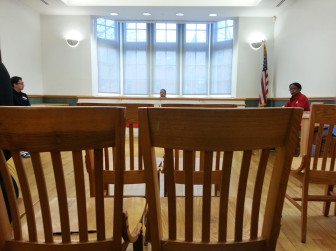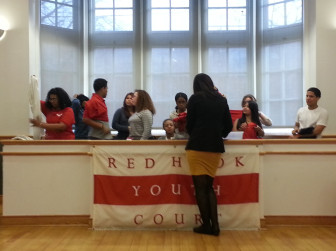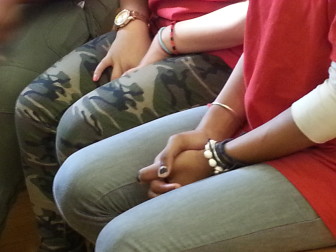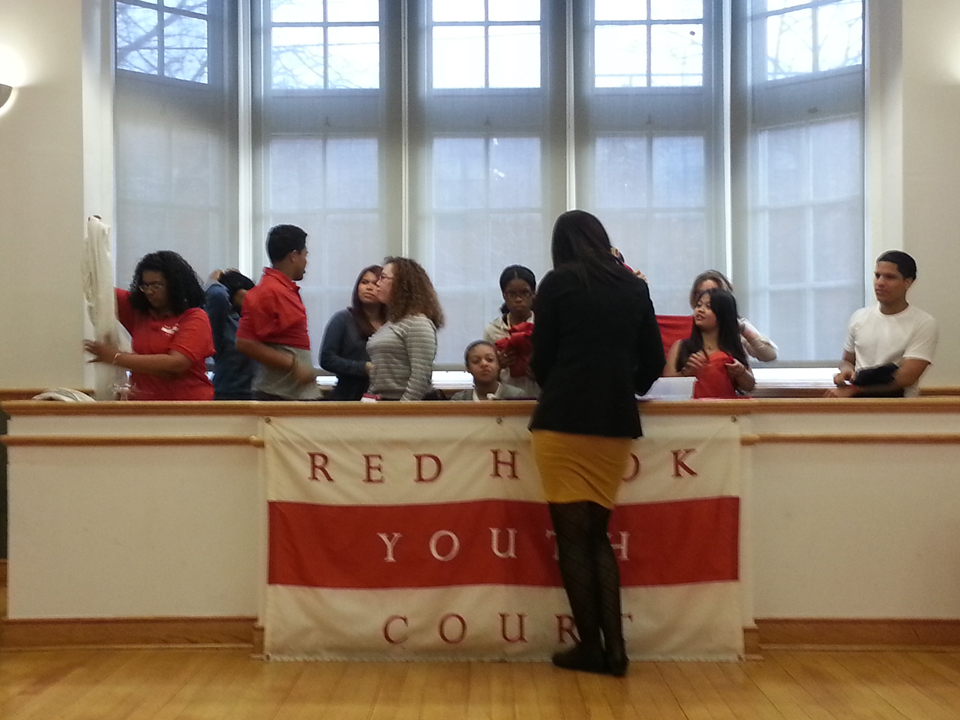 Sixteen-year-old Janelle (not her real name) is in court on a charge of attempted shoplifting. Demure, she looks from her table opposite the jury box over to her father, who’s sitting in the gallery.
Sixteen-year-old Janelle (not her real name) is in court on a charge of attempted shoplifting. Demure, she looks from her table opposite the jury box over to her father, who’s sitting in the gallery.
She’s in a Red Hook courtroom like many others in New York. But in this court, Janelle’s lawyer, the prosecution, the judge and the jury are all like her — teenagers.
This is the Red Hook Youth Court, a community-based court that handles about 150 cases every year of teens who have been arrested throughout the city. Teens end up here at the discretion of a police officer who arrests them, or after a referral from criminal court. New York’s six youth courts hear about 800 cases a year. Data suggests that these types of community-based programs do a better job reintegrating youth into their communities than the formal justice system. But the programs are limited in their ability to address the causes of youth crime.
In addition to youth court, alternative programs exist beyond the sentencing phase. Teens who have been detained or sentenced can be assigned to an alternative-to-detention program.
Youth Court

Irina Ivanova / JJIE
Teens at the Red Hook Youth Court prepare for a hearing to begin.
The hearing in Red Hook simulates a real trial, but instead of a prosecution and defense, there’s an advocate for the defendant and a community advocate. Instead of a sentence, the court hands out sanctions: community service, a letter of apology or enrollment in a counseling program.
At this trial, Rosalina, 15, serves as the community advocate. She will explain how Janelle’s crime negatively affects the community.
“We’re here to help you, not judge you,” one juror says to Janelle, who is here on attempted burglary charges, before they plunge into thorough questioning. How are her grades? What is her goal after she graduates?
“We ask them extra questions cause we want to get to know them more,” a juror explained later. The court’s decision “isn’t based just off the one offense — we ask how we can better them overall.”
The jurors ask if Janelle has any history with the police, and she describes getting caught shoplifting a year before. She takes responsibility for the earlier incident, but this time is different, she explains. A friend had given her a bag to hold that contained an alarm blocker, which the police took as evidence that she intended to steal.

Irina Ivanova / JJIE
Youth court participants change out of uniform as they prepare to go home.
“Do you understand the effect this has on your community?” a member asks.
She does. It could set a bad example for younger kids and gives a bad impression of the neighborhood.
The jury’s decision: no sanction. But they remind Janelle to be conscious of the friends she picks.
Due to its high success rate, the Red Hook Youth Court has become a model for alternative programs throughout the city that want to divert young people from the formal court system. Lawyers, school groups and community advocates regularly visit hoping to either learn from the youth court or start one in their own community.
“That’s the magic of youth court: using the peer group to self-correct behavior,” said Brett Taylor, who runs the court’s training program. Taylor, a former attorney for the Legal Aid Society, said the system is effective because teens in trouble are more likely to listen to other teens. Also, the kids who are part of the youth court are often better positioned to understand young defendants.
“Kids show more compassion than adult courts,” said Taylor, but they’re less easily fooled, “especially about school matters. I was also impressed with their ability to come up with meaningful sanctions.”
He recounted the case of one teen who regularly skipped school because he was being bullied and was in court for truancy. “All the adults in his life had failed this kid,” Talor said. The youth court’s sanction was to require that the teen join a school club or program as a “self-help measure,” Taylor said.
Truancy is the most common type of case at the Youth Court, said Sabrina Carter, the director of the youth court program (and a former member.) They also see more serious cases including assault, trespassing, burglary and fare evasion. The court has no legal means to ensure that kids show up for their cases, or complete their sanctions, but more than 90 percent of teens who go through the youth court do complete the recommended programs.
Despite its high success rate, there’s one crucial barrier preventing the creation of more youth courts in the city: money. “If we had enough funding, every neighborhood would have a youth court,” said Taylor.
Alternatives to Detention

Teen jurors confer at the Red Hook Youth Court. Photo by Irina Ivanova.
For most passing by, the eight-story faded brown building off of Chapel Street in downtown Brooklyn is one of thousands of others. But for court-involved teens, the building provides a refuge from detention center sentences.
It is home to The Center for Community Alternatives (CCA), an alternative to detention program for court-involved youth. Courts can mandate that, instead of being held in a detention center, a juvenile be sent here, or to one of the other alternative to detention programs in New York City. Program graduates believe those who go through these programs are more successful at staying out of trouble than those who go to detention centers.
“Detention is punitive,” said Ann Flynn, a case manager at the CCA who works with youth on an individual level to cater the program to specific needs. “Alternative programs such as CCA allows the youth involved to grow, learn and develop as young adults from a strengths-based perspective.”
The CCA serves approximately 400 court-involved youths annually, between the ages of 12 and 16. Those assigned here are mandated to use the center’s services, which include art classes, team-building exercises, group discussions and contraception education.
“Every youth is actively involved in the decision making process in regards to services needed,” said Flynn. For court-involved youth like Devin, 17, these services have been life changing.
“When I first starting coming, I’d come in high and leave high,” he said. Devin was referred to the CCA by a court judge after his freshman year of high school. “But I really started to appreciate the groups I had here. Now I’m back in school and have been sober for a while.”
Devin now works as a peer leader at the CCA and helps other teens through the program.
“They’re going through the same thing that I used to,” Devin said. “It’s always better for a teenager to hear it from someone else their own age.”
Fifty percent of juveniles who go through the formal court system and serve time in detention commit crimes in adulthood. While those at the CCA believe it’s too early to tell the long-term success of the program, many graduates find it’s more effective than detention.
“They’re going at it the wrong way,” said Shamik, 16, who graduated from CCA’s program last year. “It’s more of a punishment system than a helping system.” At CCA, Shamik and other teens find that they feel better supported in their success.
“Our goal is to foster community connection and engagement and is evidenced by the youth’s return,” said CCA case manager Ann Flynn.
Alongside Devin, Shamik also mentors other program participants. Shamik has found that the CCA works for one fundamental reason.
“It keeps these guys off the streets,” he said. “No kid our age really wants to spend after school days in a building and sit there with a group for hours, but it will benefit you.”
